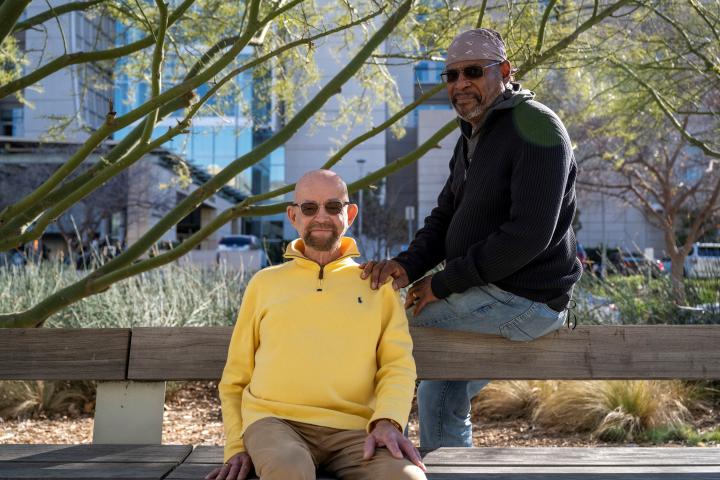Last summer, the City of Hope Hospital in California announced that one if its patients had become the fourth person in the world to have gone into long-term remission of HIV. The patient was also suffering from leukemia, and thanks to stem cell donations from a donor with a rare genetic mutation, he no longer has detectable HIV or leukemia.
Recently, he shared his story. His name is Paul Edmonds, and at 67 he is the oldest person to enter HIV remission out of the five people in the world who have achieved this. He was diagnosed in 1988, making him also the person among them who has lived with the condition the longest. He chose to tell his story to give hope to others, but also to remember the people who have died of AIDS over the last several decades.
HIV is no longer a death sentence thanks to new drugs. People on effective medication whose viral load becomes undetectable cannot pass on the virus, a phenomenal medical achievement that is summarized by the slogan U=U, undetectable = untransmissible. But the world was very different when Edmonds was diagnosed.
“I started AZT in 1988. Pretty much all of the medications that I used until the mid-1990s were horrible. The side effects from the meds were life-altering. I felt sick most of the time, and things like having to wear adult diapers and I was a young man in my 30s. Those years were rough,” Edmonds told IFLScience.
“I relied on cannabis for the nausea and appetite. It was a pretty dark period. Then when protease inhibitors became available in the mid-1990s, everything began to change. I was able to have a much clearer and hopeful outlook for the future.”
Thanks to the work of scientists and activists, therapies have improved and stigma has been challenged. People living with HIV today can expect to live a full and healthy life thanks to current treatments. Unfortunately, older HIV patients have a higher risk of developing leukemia and other blood cancers. This is due to having had a prolonged weak immune system for many years.
This was the case for Edmonds. He was diagnosed with myelodysplastic syndrome expected to develop into acute myeloid leukemia (AML) in 2018. He and his husband Arnold House, who had then been together for 31 years, moved to Palm Springs and Edmonds sought treatment at City of Hope.

Paul Edmonds and his husband Arnold House.
Image courtesy of City of Hope Hospital
AML is not easy to treat. It requires intense chemotherapy to make sure the cancerous cells are fully eradicated. Only then can healthy stem cells from a donor be given to the patient. Chemotherapy weakens the immune system, which makes the whole affair more dangerous for patients such as Edmonds on antiretroviral drugs. And unfortunately, he contracted a fungal infection during his first chemo course.
“The chemo was not as bad as I had imagined it could be. It took three different chemos to get my AML in remission. The treatment for the fungal infection in my lungs was the worst of all. The pre-transplant chemo was more difficult than the other chemo. It was one day at a time for me,” Edmonds told IFLScience.
Only after the third chemo round did the AML actually go into remission. The team from City of Hope was at the same time looking for the best match in terms of donors. They were looking for someone with a rare genetic mutation called homozygous CCR5 Delta 32. Up to two percent of the world’s population carry this mutation, which makes them resistant to acquiring HIV.
The hospital team was able to find not one, but two donors. With his AML in remission, Edmonds received the stem cells from the donor on February 6, 2019.
“I feel like I won the lottery twice. My first donor was not available after I had completed three months of chemo and they had a second donor who was available then,” Edmonds shared with us.
By the following year, there were no longer traces of HIV in the reservoir where the virus is known to be hiding. The team felt confident that he could stop taking antiretroviral drugs. Still, due to the COVID-19 pandemic, the team decided to be cautious and only take him off the meds when they could monitor his blood work regularly with less danger. It has now been two years since he stopped his anti-HIV treatment.
“I feel incredibly good. I still have to remind myself often that this is real,” Edmonds told IFLScience.
There are more and more people living with HIV to older ages and who might develop blood cancers. Paul Edmonds’ story shows that those who would benefit from a stem cell transplant might also achieve HIV remission. Work remains to be done to challenge the ignorance still surrounding HIV, to improve the lack of access to preventative drugs and effective treatments, and to eventually find a vaccine and a cure.
As Paul Edmonds shows us, there is hope. With political will and more societal empathy, the path to those changes and achievements can be shorter and smoother. Doctors, scientists, and activists across the world continue to build on the legacy of work that has been done for the last 40 years against this virus. They could definitely benefit from our continuous outspoken support.
Source Link: Exclusive: Fourth Person To Achieve HIV And Leukemia Remission Tells His Story